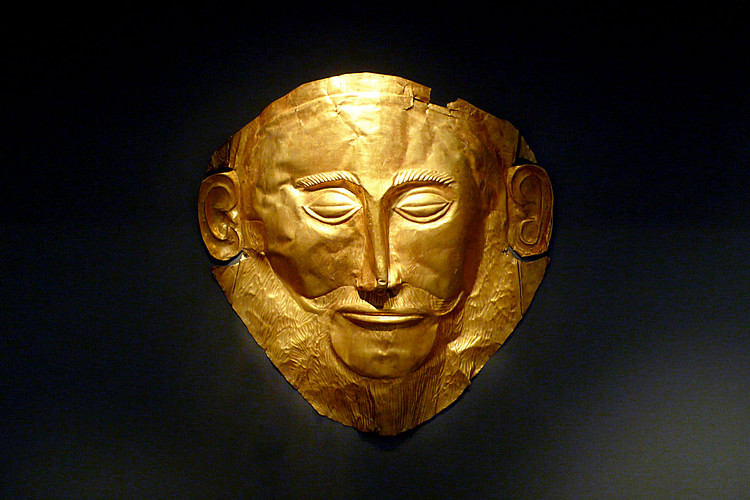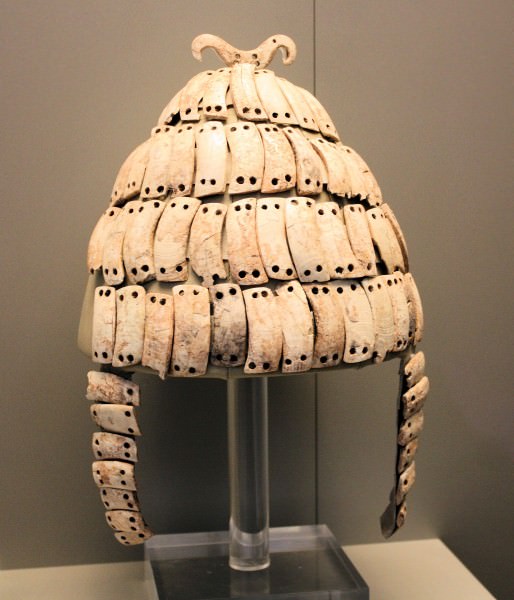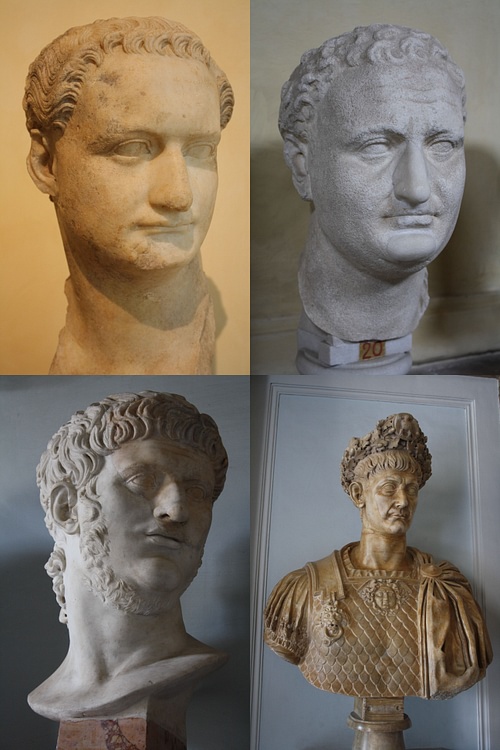Mycenaean Civilization › Suetonius » Ancient origins
Articles and Definitions › Contents
- Mycenaean Civilization › Antique Origins
- Suetonius › Who Was
Ancient civilizations › Historical and archaeological sites
Mycenaean Civilization › Antique Origins
Definition and Origins

The Mycenaean civilization flourished in the late Bronze Age, from the 15th to the 13th century BCE and extended its influence not only throughout the Peloponnese in Greece but also across the Aegean, in particular, on Crete and the Cycladic islands.The Mycenaeans were influenced by the earlier Minoan civilization (2000-1450 BCE) which had spread from its origins at Knossos, Crete to include the wider Aegean. Architecture, art and religious practices were assimilated and adapted to better express the perhaps more militaristic and austere Mycenaean culture.
MAJOR MYCENAEAN CENTRES
Major Mycenaean centres included Mycenae (traditional home of Agamemnon ), Tiryns (perhaps the oldest centre), Pylos (traditional home of Nestor), Thebes, Midea, Gla, Orchomenos, Argos, Sparta, Nichoria and probably Athens. Beyond trading relations, the exact political relationship between these centres is not clear. However, there were many shared cultural features such as architecture, frescoes, pottery, jewellery, weaponry, and of course, the Greek language and writing in the form of Linear B (an adaptation of the Minoan Linear A).
THE MYCENAEAN MEGARON WAS THE PRECURSOR FOR THE LATER ARCHAIC AND CLASSICAL TEMPLES OF THE GREEK WORLD.
MYCENAEAN ARCHITECTURE
A large palace complex has been found at most of the Mycenaean centres. These complexes, whilst displaying some site-unique developments, also display important architectural features in common. The complexes were built around a large rectangular central hall or Megaron. The Mycenaean Megaron was the precursor for the later Archaic and Classical temples of the Greek world and consisted of an entrance porch, a vestibule and the hall itself. This was the heart of the palace and contained a large circular hearth (usually more than 3m in diameter) with four wooden columns supporting a holed ceiling or light-well. It was also the throne room of the ruler or wannax. There is usually a second, smaller hall (Queen's Megaron ), many private apartments and areas set aside for administration, storage and manufacturing. Rooms were richly decorated with fresco paintings on the walls and plaster painted floors. Regarding materials, rooms in the palace were constructed with rubble fill and cross-beamed walls covered in plaster inside and limestone blocks outside. Columns and ceilings were usually of painted wood, sometimes with bronze additions.
The whole palace complex was surrounded by a fortification wall of large unworked blocks (termed Cyclopean as it was believed that only the Cyclopes could have moved such massive stones). Such walls could reach 13m in height and be as much as 8m thick. Corbel galleries - arched corridors created by progressively overlapping stone blocks, circular stone tombs with corbelled roofs, and monumental doorways with massive stone lintels with relieving triangles are also common features of Mycenaean sites. Other Mycenaean architectural structures include damns for flood management, particularly at Tiryns, and bridges built from large roughly-hewn stone blocks.

Mycenaean Boar's Tusk Helmet
TRADE
That the Mycenaean civilization had trading contact with other Aegean cultures is evidenced by the presence of foreign goods in Mycenaean settlements such as gold, ivory, copper and glass and by the discovery of Mycenaean goods such as pottery in places as far afield as Egypt, Mesopotamia, the Levant, Anatolia, Sicily and Cyprus. No doubt perishable goods such as oil and wine were also significant Mycenaean exports.
MYCENAEAN ART
In art as expressed in fresco, pottery and jewellery, the Minoan love of natural forms and flowing design was likewise adopted by the Mycenaean artisans but with a tendency to more schematic and less life-like representation. This new style would become the dominant one throughout the Mediterranean. Geometric designs were popular, as were decorative motifs such as spirals and rosettes. Pottery shapes are much like the Minoan with the notable additions of the goblet and the alabastron (squat jar) with a definite preference for large jars. Terracotta figurines of animals and especially standing female figures were popular, as were small sculptures in ivory, carved stone vessels and intricate gold jewellery. Frescoes depicted plants, griffins, lions, bull-leaping, battle scenes, warriors, chariots, figure-of-eight shields and boar hunts, a particularly popular Mycenaean activity.

Mycenaean Fresco
MYCENAEAN RELIGION
Little is known for certain regarding Mycenaean religious practices beyond the importance given to animal sacrifice, communal feasting, pouring of libations and offerings of foodstuffs. The presence of double axe carvings and horns of consecration in art and architecture suggest strong links with the Minoan religion, although these symbols may have been adopted because of their political resonance. Architectural features such as sunken basins and fresco depictions of altars hint that the Megaronmay have had a religious function. Many centres also had specific sanctuary sites for worship, usually close to the palace complex. It is clear that burial was an important ritual as evidenced by the presence of monumental tholos tombs, prominent grave sites and the quantity of precious objects which were buried with the dead - golden masks, diadems, jewellery and ceremonial swords and daggers.
With the mysterious end of the Mycenaean civilization during the Bronze Age Collapse around 1200 BCE (possibly through earthquake, invasion or in-fighting) came the so-called Dark Ages and it would be many centuries before Greek culture would finally regain the heights of the late Bronze Age.
MAP
Suetonius › Who Was
Definition and Origins

Gaius Suetonius Tranquillus (c. 69 – c. 130/140 CE), better known simply as Suetonius, was a Roman writer whose most famous work is his biographies of the first 12 Caesars. With a position close to the imperial court he was able to access otherwise private sources for his work, and he certainly did not hold back on revealing the sometimes sordid details of Rome ’s most famously debauched emperors.
SUETONIUS' LIFE
Although a biographer of others, Suetonius tells his readers very few details of his own life. The exact date of birth of Suetonius is not known for certain but the most agreed upon range is between 69 and 75 CE. Also uncertain are his place of birth (perhaps either Umbria or Bithynia-Pontus in northern Africa) and the year of his death. Suetonius' grandfather was possibly a member of Caligula ’s court and the writer's father, Suetonius Laetus, was a knight, that is, a member of the equestrian class, holding the position of tribune of the 13th legion during the 69 CE civil war, a legion he commanded at the Battle of Bedriacum in northern Italy.
SUETONIUS WAS DIRECTOR OF THE IMPERIAL LIBRARIES AND THEN A PRIVATE SECRETARY TO HADRIAN.
Some biographical details can be found in the letters of that other famous Roman writer Pliny the Younger, the two being good friends. Suetonius, we are told, was a quiet man who first studied and practised law before becoming a professional scholar.Pliny compliments Suetonius on his writing and poetry - even recommending him to Emperor Trajan - although he chastises him for being slow to finish his work. In c. 110 CE he was offered the position of military tribune in Britain but declined for unknown reasons. Of his later life we know that Suetonius was director of the imperial libraries and then a private secretary to Hadrian, although he was dismissed from this position, again for unknown reasons, perhaps after a lack of protocol and good manners to Empress Sabina. Significantly, this role allowed Suetonius not only to travel with Hadrian to Gaul, Germania, and Britain in 121-122 CE but also to access the state archives and the private letters of previous emperors such as Augustus.
THE TWELVE CAESARS
Suetonius' most famous work is his collection of biographies of Julius Caesar and the first 11 Roman emperors, known simply as The Twelve Caesars ( Caesares or De vita Caesarum ). The biographies are not wholly flattering nor are events told in chronological sequence but they reveal some candid details of Rome's first citizens. The subjects are:
- Julius Caesar (first few chapters now lost)
- Augustus
- Tiberius
- Caligula
- Claudius
- Nero
- Galba
- Otho
- Vitellius
- Vespasian
- Titus
- Domitian
Although Suetonius takes care to try and use direct quotes and sayings the emperors were known to have used, and he does use written sources whenever possible; he does, at times, present a rather haphazard series of observations, even compared to ancient historians such as Plutarch and Tacitus. Nevertheless, Suetonius was not intending to write a comprehensive history of these great men but rather provide an insight into their strengths and frailties. He also refrains from inserting his own moralising judgments, something both earlier and contemporary writers could not resist doing. In addition, in many instances Suetonius is our only source of information, and so his writings have become as valuable as they are entertaining.
OTHER WORKS
Besides this important work Suetonius also wrote many other books which now are either lost or survive only in fragments. He produced another collection of biographies titled On Illustrious Men ( De viris illustribus ) which described the lives and works of various scholars, poets and rhetoricians, including Virgil, Horace, and Lucan. Two other surviving biographical collections are his On Famous Courtesans and On the Kings, and he also wrote De re publica about the great statesman Cicero.
Suetonius provides valuable historical data in a book titled Roma which covered the various customs, festivals, and even clothing worn in the Roman capital. A similar book of his dealt with Greek games. He also wrote several works on natural history and languages: On Mankind, On Nature, On Keeping Time, On Greek Terms of Abuse, Grammatical Questions, and On Critical Marks in Books.
Below is a selection of extracts from Suetonius' Twelve Caesars :
[On Julius Caesar] …on the day before his murder he had dined at Marcus Lepidus' house, where the topic discussed happened to be 'the best sort of death' – and "Let it come swiftly and unexpectedly", cried Caesar.
[On Augustus] Antony ’s brother Lucius added that, after sacrificing his virtue to Caesar, Augustus had sold his favours to Aulus Hirtius in Spain, for 3,000 gold pieces, and that he used to soften the hair on his legs by singeing them with red-hot walnut shells.
[On Tiberius] Even as a young officer he was such a hard drinker that his name, Tiberius Claudius Nero, was displaced by the nickname 'Biberius Caldius Mero' – meaning 'Drinker of hot wine with no water added'.
[On Caligula] The method of execution he preferred was to inflict numerous small wounds; and his familiar order: 'Make him feel that he is dying!' soon became proverbial. Once, when the wrong man had been killed, owing to a confusion of names, he announced that the victim had equally deserved death; and often quoted Accius' line: 'Let them hate me so long as they fear me'.
[On Nero] It was strange how amazingly tolerant Nero seemed to be of the insults that everyone cast at him, in the form of jokes and lampoons…in Greek or Latin, posted on city walls or current orally: 'Alcmaeon, Orestes, and Nero are brothers. Why? Because all of them murdered their mothers'.
Vespasian was square-bodied, with strong, well-proportioned limbs, but always wore a strained expression on his face, so that once, when he asked a well-known wit: 'Why not make a joke about me?' the answer came: 'I will, when you have finished relieving yourself'.
[On Domitian] He also claimed that the lot of all Emperors is necessarily wretched, since only their assassination can convince the public that the conspiracies against their lives are real.
LICENSE:
Article based on information obtained from these sources:with permission from the Website Ancient History Encyclopedia
Content is available under License Creative Commons: Attribution-NonCommercial-ShareAlike 3.0 Unported. CC-BY-NC-SA License